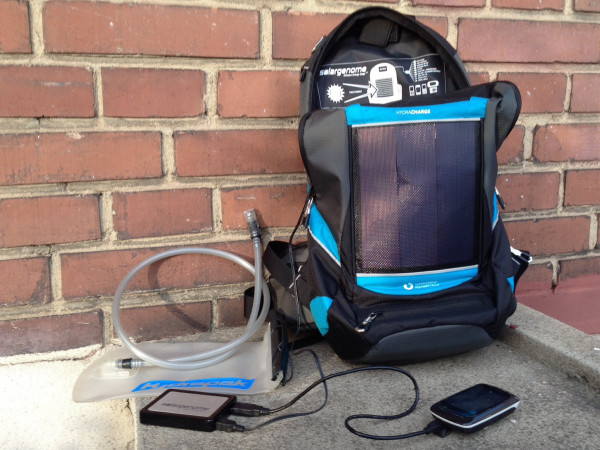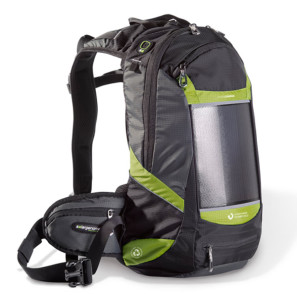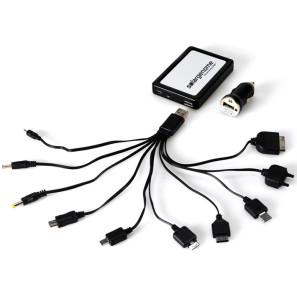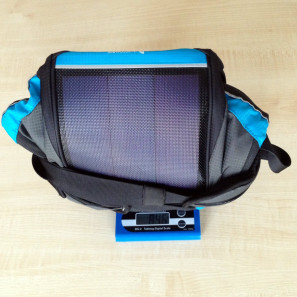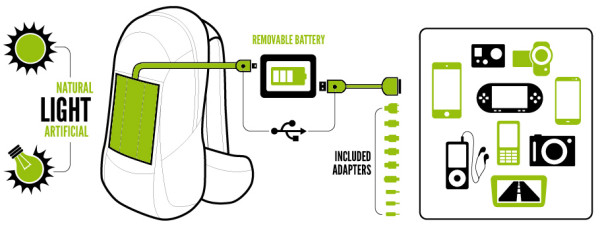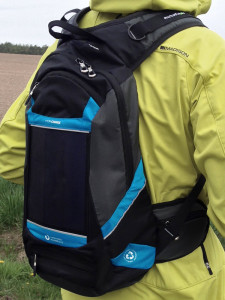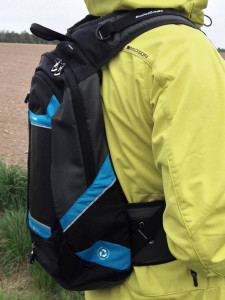Two and a half years back we did a intro article about this photovoltaic-packing hydration bag that promised to charge your gadgets on the go, and we kind of left it at that. See then, most of us had a mobile phone that held a charge for a couple of days with limited other functionality and only some of us had a GPS on every ride. In any case, personal electronics hadn’t really taken over cycling so much and so there really wasn’t a constant need for more power. Now almost every ride gets tracked with a GPS or smartphone to upload to Strava, gotta get pics up on Instagram or it didn’t happen, why not upload some sick edits from the GoPro to Youtube, and surely we need to notify the world on Facebook and Twitter; and with all that comes a constant drain on our devices. Sure it’s fine on a 2hr ride, but what about that all day epic? Our followers don’t want to miss that, right?
OK, well thankfully it isn’t as crazy as that for most of us. But I can personally attest to finishing a ride on the last legs of an iPhone battery after using mobile maps to chart an alternate way home after an overnighter when my Garmin’s battery drained. This solar powered backpack from Solargenome seems like a pretty solid alternate to keep the electronics going as long as your adventures do.
Come past the break to see our first impressions of riding with the bag, powering our devices, and see its current discount…
Tech Details & Actual Weights
Not much has really changed since our previous post with the Hydracharge, more just our need for it. The bag has a total volume of 7.2 liters, three main outside pockets, one on each side of the hip belt, plus several interior dividers. It includes a 1.5l BPA-free Hydrapak reservoir. The bag’s back is pretty much smooth so ventilation isn’t excellent, but the pads at the hip and shoulders do keep it off the back a bit for decent airflow. With cooler weather we haven’t really had a chance to experience the ventilation much yet, though.
The flexible solar panel is 14cm x 17cm and rated at 2W of generated power at 450mA. That feeds into the Lithium Ion battery, which can store 1500mAh of juice. (That’s about the same as an iPhone 5/5S or Samsung Galaxy S2 battery, less than new generations of either; or about 50% more than any of the GoPro or Garmin batteries.) It takes about 4 hours to charge the battery in full sun, maybe 2x longer on an overcast day, and an hour when plugged into a USB port. The battery itself weighs an actual 72g. The battery setup also comes with a car USB charger and what they’ve named an Octopus universal charger cable, which actually outputs to 10 common plugs including micro and mini USB, Apple 30-pin dock, and several other phone standards (but not Apple’s Lighting.)
The whole system including the bag, battery and charging cables, and hydration reservoir weights 846g. The bag is currently on sale for 10% off for a price of 135€, including free shipping in the EU or 10€ worldwide. While the brand Solargenome is a bit unheard of, it is part of parent company ASG International, who happens to also own Scicon bags among a few other brands. That relationship just means that the bag is pretty solidly made, and customer support and warranty service should be reliable as well.
Our Thoughts
Well, the idea of keeping my devices charged was pretty promising. In practice the bag probably won’t keep me going for several days without power, but seems up to the task for a long day or two. The capacity of the solar panel and battery is limited to keep more basic devices going, so it won’t be able to keep up with web browsing on a tablet or even bigger smartphones. But by pre-charging the battery ahead of a sunny weekend trip, it had no problem keeping my iPhone 5 and Garmin 800 running for 2 full days with normal use. I became less worried about taking a bunch of pictures, and tracking a ride with my phone. In fact, the battery itself is a nice accessory that provides a reasonable amount of backup power for a long day on the bike, and will surely go along on many all-day trips where a backpack would be unwarranted.
The bag/solar setup doesn’t really add much weight more than my regular backpack, so it seems like it could make sense for those longer, more isolated outings. Will it make it on every ride? No; my regular Camelbak is a little more comfortable and better ventilated, and will remain my trusted go-to for shorter mountain rides. But the Solargenome will be a key piece of kit when summer days get long and 12 hour trips sound like a good idea again, and even more so for some lightweight summer sub-24hr overnighter bikepacking trips.
Is solar power a viable solution for powering our gadgets on long rides? I don’t know.
For extended touring, a hub dynamo makes a lot of sense, but there is something to be said for the flexibility of a pack that can easily go from bike to bike. On a lot of long rides I don’t really want to be wearing a backpack all day, but it should be fine for a couple of days of off-road bikepacking. I don’t know if Solargenome will develop new product solutions, but I think this won’t be the last solar power for the bike that I add to my arsenal.
